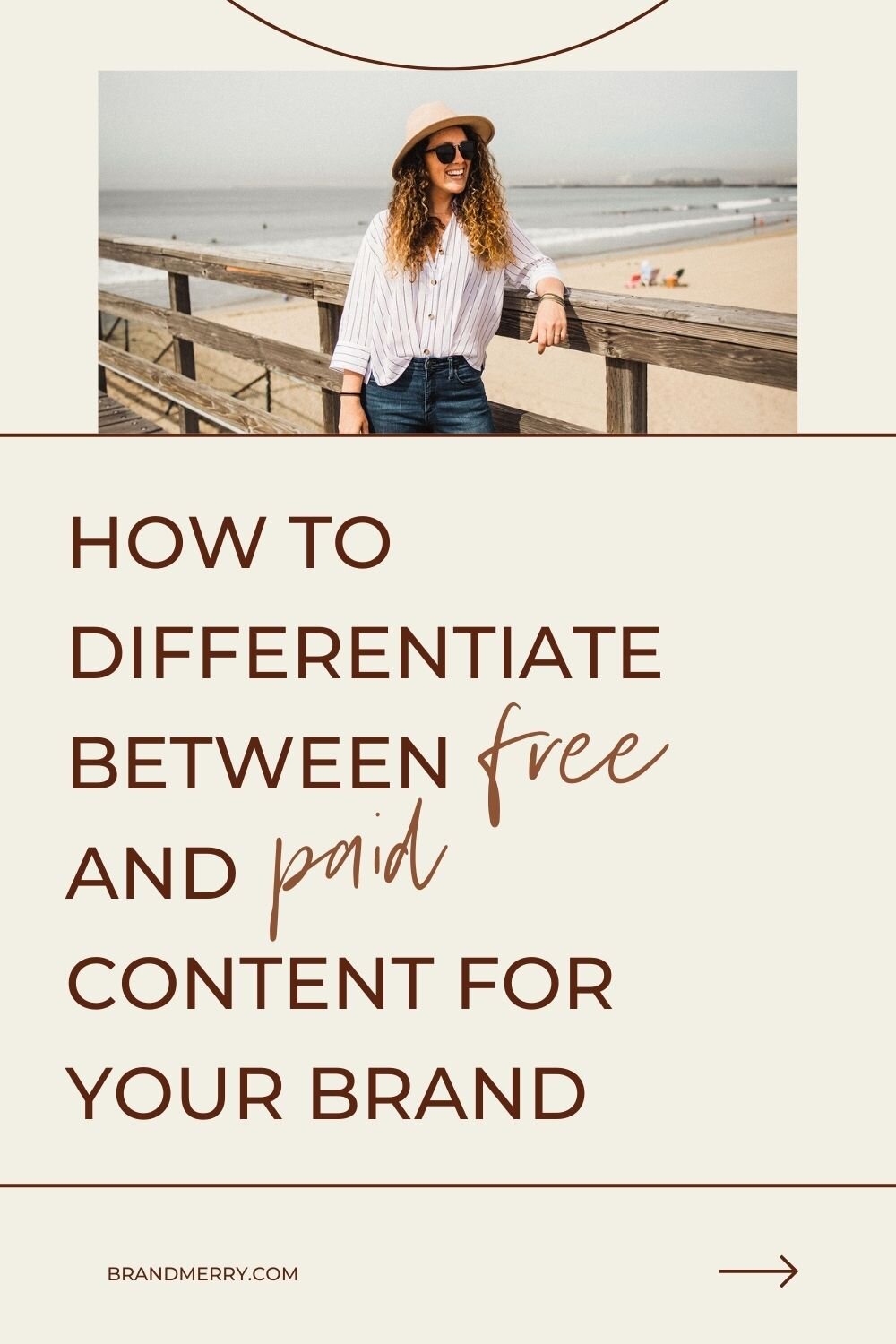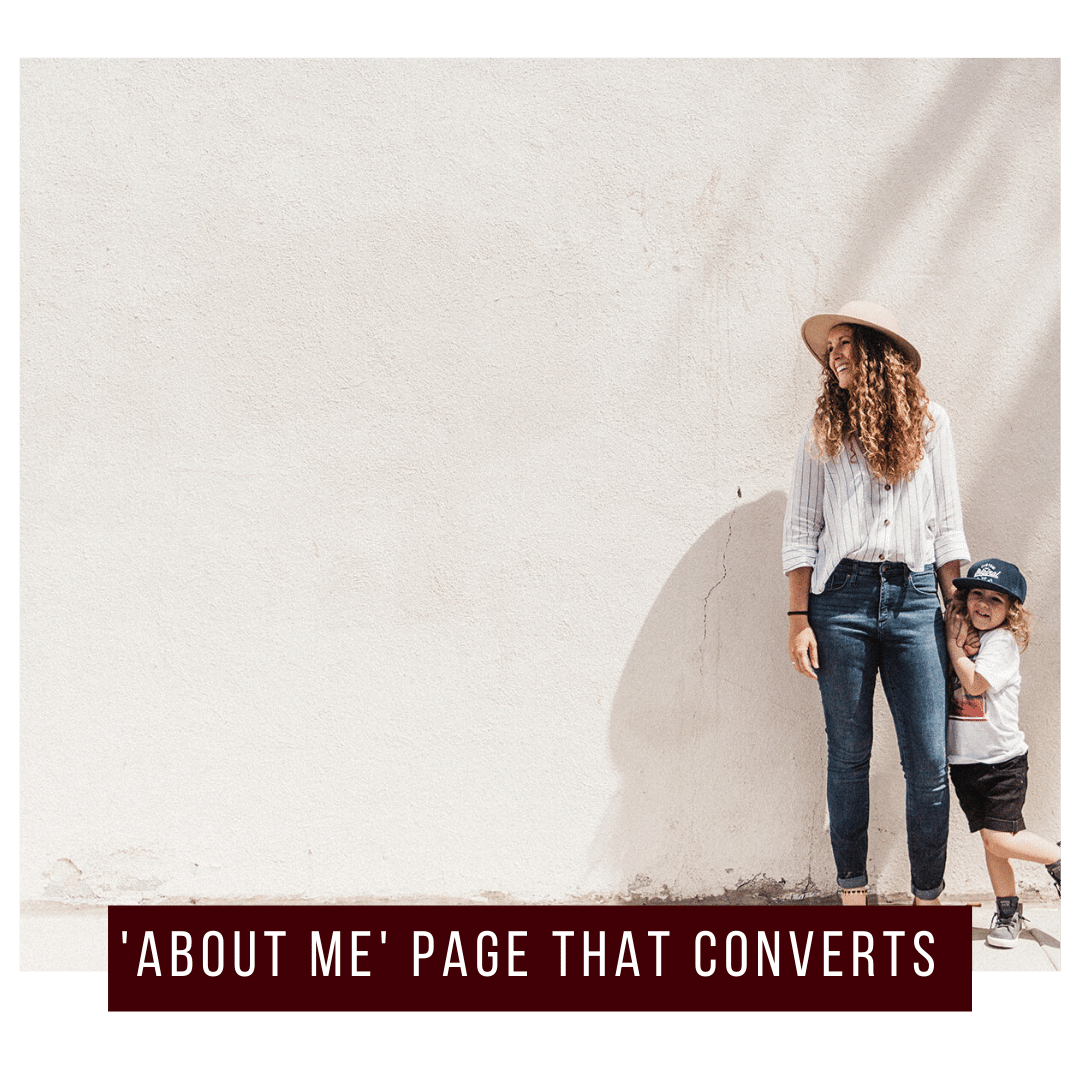The Difference Between Free and Paid Content as a Content Creator
One of the top questions I receive is, “If I'm marketing my business and I want to get people on my email list through a freebie, how do I know what to give them? If I want to write blog posts, I don't want to give away everything I do in that blog post, I want people to buy from me.”
So we're going to break it down and I’m sharing the difference between free and paid content.
When you think of your free content you’re probably thinking of blog content, reels on Instagram, TikTok, YouTube videos, podcasting, free gifts, email marketing, etc...
What should you include in your free content vs your paid content and why is the difference between the two so important?
FREE MARKETING CONTENT
You've got your free marketing content.
That's the kind of content that you're creating on a regular basis as part of your weekly workflow that you put out to bring in an audience.
That content is the first level. That is really meant to do a few things. But one of the main things is to attract new customers.
We always want to be focused on branding and brand awareness. So making new people aware of our brand, a cold audience, as it's often described in our industry.
You want to attract people who don't know anything about you through your free content. That's how we make sure you have a consistent, ongoing, flow of people coming in, who are interested in your offers.
That content can also serve your existing audience, giving them value, warming them up, and nurturing them as well. But when you're creating your content, I always want you to think about creating it for people who don't know you yet.
CREATING A FREEBIE OR LEAD MAGNET
Then in the same bucket of free content, we also have a freebie or a lead magnet. So we recommend over here at Brandmerry, that every business have some sort of freebie or lead magnet. Yes, even product-based businesses. And I'll give you an example of one in just a minute.
This free lead magnet is what you are ultimately going to give people in exchange for their name and their email address.
Let's say you write a blog post on four ways to improve your business.
Someone finds that blog post.
They read that blog post.
They love it.
They're like, "Hey, I like this person. I would like to learn more about this person. And I would like to be in their inner circle and I would like more free things."
So they see that you have a freebie that says, 10 Steps to Starting an Online Business. Great! They give you their name.
They give you their email address.
They're on your email address.
They get that freebie.
It's that next level. It takes somebody from cold to warm.
Let's say you sell a product. My favorite example to use is skincare. Let's say you have a skincare business.
You have people who are coming to your website.
You have a blog on different ingredients to use for different skin problems.
Maybe you have a video that shows how to correctly apply a skincare routine in the correct order, some free content.
Somebody consumes that content on your website, on YouTube, wherever, and they're like, "Hey, I want a little bit more."
They see that you also have a quiz that will help them identify what kind of skin they have and the top products that you recommend.
They have to put in their name and their email address to get the results from the quiz.
On the quiz results, you tell them, but you also are pitching some of your products as a solution. That is a lead magnet.
Every business can create some sort of lead magnet.
Then, of course, we have the paid content and that's what's behind a paywall.
That can be a product that you sell, an ebook, a course, a group program, a one-on-one, consulting, whatever it is, that's behind the paywall. Someone has to pay to get that content from you.
When you're thinking about why free content is important, I hope that you see this sequence of events.
They're important because you want to constantly get your brand in front of new clientele. You want to give them value so that they are eager to learn more from you and join your inner community, your email list.
And then you want to continue to show up for them leading them to the sale.
THE CONSUMER BUYING PROCESS
This sequence is also essential when we look at the information around the consumer buying process, something a lot of people don't talk about. I have an entire YouTube video on it and a blog post about it, where I share with you the stages of the consumer buying process.
There are people who are at stage one who are aware they have a problem, but they know nothing else. They don't know about the solutions.
Maybe they're on Google, just looking for solutions to their problem. How powerful would it be if they found a blog post by you, were introduced to your brand and your business and joined your email list?
Now those people are less likely to buy right away, but we can speed them up through the buying process by giving them value, building trust, leading them to where they're ready to invest.
But you've also got people who are ready to invest, who are seeking out the solution, who knows exactly what they need, and they're just seeking out the person and the brand to give it to them.
They're ready to buy, but maybe they just need to read a blog post or watch a YouTube video so that they know that you know what the hell you're talking about.
People are coming in contact with your brand at different stages and we really have to keep that in mind as marketers.
We cannot assume that everybody that lands on our website are just ready to whip out their credit card. We know that that's just not true.
So when you're creating free content, it's important that you keep that in mind, because then you are able to, not only make someone aware of your brand but then attract them and keep them engaged so that when they are ready to buy, they buy from you, rather than losing them.
Because if the only thing that they can get from you is, "I've got this offer." Well, they're not ready yet. And I think that's something that we don't talk about a lot.
Sometimes people just aren't ready for multiple reasons.
Show up for the people who maybe just aren't ready yet.
Don't lose them.
They're going to move to somebody else if you don't show up and create content for them.
Free content is very important.
THE DIFFERENCE BETWEEN FREE AND PAID CONTENT
So now the question becomes, what is the difference?
What is the difference between the two?
What I’m going to tell you is going to make this entire process so much easier.
When you think of your free content, think about giving your audience the ‘What’ and the ‘Why’.
So what do they need to do?
What needs to happen, what do they need to change?
Why does that need to happen?
Why does that need to change?
Why should they think about something differently?
Why is this information important?
And the paid content is the ‘How’.
PRODUCT-BASED BUSINESS EXAMPLE
So let's use the example of my skincare line, yet again. Let's say we have a blog post, and it's talking about three of the top ingredients that you should avoid in your skincare. That's a What. I also could incorporate why you have to avoid them. So I'm hitting a What and a Why in one blog post.
Then I want to share with my audience, through my freebie, how they can clean up their skincare products and the type of products, ingredients they should be focused on, because of their specific skin things.
So the quiz that I'm giving them is further diving into What they should be focused on and the Why for their particular answers. It's just another level of free.
The first level was broad, it could apply to anyone that was reading the blog.
Now they're answering very specific questions in my quiz, but I'm still giving them the What and the Why.
But I'm also, on the results page, after they've given their name and their email address, starting to give them the How.
These are the specific products for how you do it.
SERVICE-BASED BUSINESS EXAMPLE
When it comes to a service-based business, let's say the ‘What’ is “Four Tips for New Entrepreneurs”. These are four things that they could be doing.
Then, once they've read those four ‘What’ elements, give them the Why. For this particular instance, I would definitely do What and Why.
For example, I would share that you need to have a solid brand.
What is a solid brand? Giving an overview of what a solid brand is.
I’d also share why it's important.
Next, I’d share that they need to grow your community.
What does that mean to grow your community?
What specific elements do you need?
Why are those important?
Next number three, would be the marketing strategy.
What is a marketing strategy?
What is not a marketing strategy?
And why is that important?
Next-level is selling with confidence.
What does that mean?
Why is that important?
So this is the blog. This is what I've given them. The What and the Why.
To follow the blog, I’d offer my lead magnet that dives into “15 Lessons To Propel Your Business,” which goes deeper into the free content, and then I’d invite them to join my program, Roadmap to Freedom where I will give them the How.
So in the blog post, I said, "Hey, this is what branding is. This is why it's important." And then the How, I'm actually teaching them each of those individual pieces.
GIVING IT ALL AWAY
When you look at it like this, you're not giving it all away. I am a firm believer that you can't give it all away in your free stuff because they'll always get more from your paid courses, your paid group programs, your paid products, services, all of it.
They always will.
FREE CONTENT TO PAID CONTENT EXAMPLE
For example, the stages of the buying process is something that I've openly talked about. I have a YouTube video about that. It's also something that I teach inside of my programs.
So if you come into the program, most people will already have an understanding of the consumer buying process, if they've consumed those pieces of content, but not everybody has.
So I need to reiterate that inside of the program as well.
But then in the program, I'm talking specifically about how you reach customers at each of those stages.
So even though I've given you the stages for free, I haven't dived into how you reach people at those stages in the most efficient way. That happens inside my program.
Are you starting to see the difference?
When you're setting up your free content, I want to specifically think about your freebie, your lead magnet, to intrigue your audience, to give them incredible value, and I'm going to talk about that in just a second, and to set up your offer. That is the goal.
Because if someone is like, "Ooh, I want to hear more," they're moving further along in the consumer buying process, they're now into a place where they're seeking really solid solutions that they're looking to invest in.
You want whatever you're giving away as your lead magnet to be valuable and to set up the offer, to also intrigue your audience, so they need and want to learn more from you.
WHAT DOES ‘GIVING VALUE’ MEAN?
Giving value can mean so many different things.
I often talk about giving value as being inspirational, motivational, obviously educational, and also entertaining.
Yes, your content could also just be funny. That's value, making someone laugh is giving them value in their life.
But when you think about giving value on an educational level, like in a free gift or a lead magnet, I want you to think that the value piece can simply be answering a question that has been floating around in their minds forever and ever and ever.
So when I first was thinking about releasing my Brand Roadmap, which is a freebie that I've had, I went back and forth with myself, wondering if it was valuable enough.
And I realized after I put it out there and I started talking with people, that it was exactly what they needed because branding was overwhelming to them.
They didn't understand what branding was and that was keeping them from moving forward and creating their brand.
So by creating a PDF for them, that clearly gave them the stages and in what order, not only did I remove the overwhelm, but I gave them the information they needed to start taking action. And it beautifully set up my offer, where I would teach them how to do that.
So when you think about giving value, don't always think that you've just got to give all your information away.
It's really understanding your ideal customer, the questions that they need to be answered, that they would pay money for, but you're going to give it to them for free.
That's what you want to deliver.
That's why knowing your ideal customer is so incredibly important because when you know your ideal customer, you know what questions they have and you can answer those questions in a very valuable way.
The last thing that I'll say about this is, don't beat yourself up if you want to trickle in the ‘How’, that’s ok! Every once in a while you can give some ‘How’ information because remember, you can’t give it all away!
I can talk about branding in a hundred different ways. If I tell one person how to craft a hook, which I've said, “Your hook is specifically who you are, who you serve, what they struggle with, what they want, and how you support them. Solve that problem.” I can give you the formula for that.
But guess what? You've got to know all those other pieces for that to work. So even though I've given a little piece of the How, I know that in order to make that work at the highest level, you need to come work with me.
CONCLUSION
Free content is necessary in order to bring in clients, making them aware of your brand and moving them through the buying process, to being a paying client.
Bringing somebody in who doesn't know anything about you, warming them up, making a connection with them, and getting them to invest.
That free content that you're creating is focused on the ‘What’ and the ‘Why’.
And the paid content is focused on the ‘How’ - how they actually do those different things.
If you found this free content incredibly valuable, I want you to know that there's so much more to creating free and paid content.
And it's one of the pillars that I teach inside of my program, Roadmap to Freedom.
The doors for Roadmap to Freedom are opening on Sunday. You can go to Brandmerry.com/freedom to learn more and get ready, the doors are only going to be open for four days. That's it. It's the shortest launch period we've ever had.
You're going to want to be ready to go when the doors open, so you don't miss the deadline, because doors will not open again until next year.
When we're talking about the free versus paid content specifically, that is something that we go into in depth inside of Roadmap to Freedom, where I teach you how to come up with free content ideas, how to strategically create a freebie that's going to lead to the paid offer, so that you've got people joining your email list and then moving effortlessly to the paid offer.
Learn more at brandmerry.com/freedom.
P.S. Planning and creating your content doesn't have to be a constant struggle. There is a better way to research, plan, and create your content as an entrepreneur and it's all inside the Content Planning Blueprint!
The Content Planning Blueprint is perfect for online business owners who know the power of content creation but are tired of spending all of their time coming up with ideas, organizing their content, and wondering what will attract their dream clients.
In just a few hours, you'll have 90 days of content planned, a repeatable workflow to save you hours on creating and distributing your content every week, and content topics that will keep performing for your brand for years to come! Get your blueprint now >>
- FREE GIFTS YOU'LL LOVE -
DISCOVER YOUR BRAND STORY IN UNDER 5 MINUTES
LEARN HOW TO WRITE AN ‘ABOUT ME’ PAGE THAT CONVERTS
MAP OUT 30 DAYS OF CONTENT IN UNDER AN HOUR
- READ THE LATEST POSTS -
MEET MICHELLE
Hey there, I'm Michelle Knight and I an online branding and marketing consultant for female entrepreneurs.
I believe in the power of storytelling and using that superpower to brand and market yourself online...oh and to set yourself free.
I'm obsessed with living a life of freedom, so much so, that my family and I now travel full-time while running my business from the road.
This blog serves as a home base for all things branding, marketing, content creation and more.












